

Learning and Teaching Home. Danielson Group » The Framework. Loading...

Reach Students : Professional Practice. The CPS Framework for Teaching is a modified version of Charlotte Danielson's Framework for Teaching.
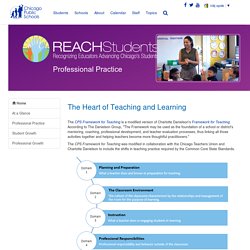
According to The Danielson Group, "The Framework may be used as the foundation of a school or district's mentoring, coaching, professional development, and teacher evaluation processes, thus linking all those activities together and helping teachers become more thoughtful practitioners. " The CPS Framework for Teaching was modified in collaboration with the Chicago Teachers Union and Charlotte Danielson to include the shifts in teaching practice required by the Common Core State Standards. The CPS Framework for Teaching organizes the work of classroom teachers into four domains.
The four domains are described in the visual above. In addition to the CPS Framework for Teaching, these are the seven CPS Frameworks that measure professional practice for non-classroom educators: AlysaPortfolio - Danielson's Framework. "Teaching is a holistic endeavor; all the different aspects of teaching are entangled in multiple ways.
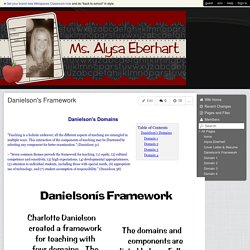
This interaction of the components of teaching may be illustrated by selecting any component for furter examination. " (Danielson 31) ~ "Seven common themes pervade the framework for teaching: (1) equity, (2) cultural competence and sensitivity, (3) high expectations, (4) developmental appropriateness, (5) attention to individual students, including those with special needs, (6) appropriate use of technology, and (7) student assumption of responsibility. " A Formative Evaluation: Chapter 3. 3.2.1.3.3 Autonomy In The Classroom If we accept Bruner's definition of instruction as "a provisional state that has as its objective to make the learner or problem solver self-sufficient" (1966b:53), then all learners need to learn to be independent of the teacher (Dickinson 1992:2), whose role it is to facilitate this.
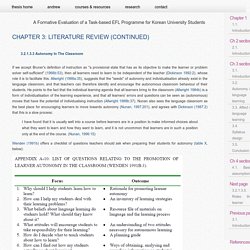
Allwright (1988a:35), suggests that the "seeds" of autonomy and individualisation already exist in the language classroom, and that teachers can therefore identify and encourage the autonomous classroom behaviour of their students. He points to the fact that the individual learning agenda that all learners bring to the classroom (Allwright 1984b) is a form of individualisation of the learning experience, and that all learners' errors and questions can be seen as (autonomous) moves that have the potential of individualising instruction (Allwright 1988b:37).
The course reflects learners' goals in its language tasks, and strategies. Constantly Tweaking Teaching and Learning by. This is a simple blog about teaching and learning tweaks in a landscape without (one-off) lesson grades.
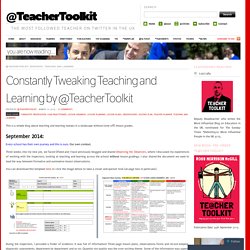
September 2014: Every school has their own journey and this is ours. Our own context. Three weeks into my new job, we faced Ofsted and I have previously blogged and shared Observing the Observers, where I discussed my experiences of working with the inspectors, looking at teaching and learning across the school without lesson gradings. I also shared the document we used to lead the way between formative and summative lesson observations. Technology Standards - Melvin W Smith Jr. Teaching and learning framework in mathematics. Outcomes-based eLearning at CUHK. Background.
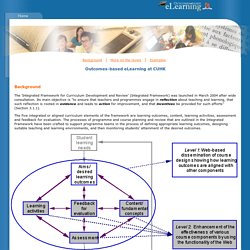
Changing the Learning Landscape : Teaching Approaches and Technologies That Support Them. Ian Glover and Stuart Hepplestone of Sheffield Hallam University presented their framework for identifying different teaching approaches in use at their University and the technologies that can support or enhance them.
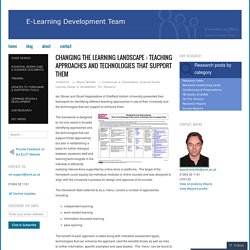
The framework is designed to not only assist in broadly identifying approaches and the technologies that can support those approaches but also in establishing a basis for further dialogue between academic staff and learning technologists in the interests of efficiently realising interventions supported by online tools or platforms. The target of the framework could equally be individual modules or entire courses and was designed to align with the University’s process for design and approval of its courses. The framework itself (referred to as a ‘menu’) covers a number of approaches including: Curriculum for Excellence: Building the Curriculum 3: A Framework for Learning and Teaching. Optimal learning model. An adapted version of this post can also be found at Ed Tech Magazine’s website here.
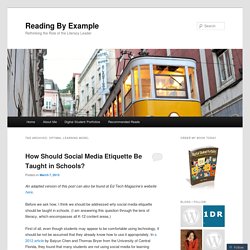
Before we ask how, I think we should be addressed why social media etiquette should be taught in schools. (I am answering this question through the lens of literacy, which encompasses all K-12 content areas.) First of all, even though students may appear to be comfortable using technology, it should be not be assumed that they already know how to use it appropriately.
In a 2012 article by Baiyun Chen and Thomas Bryer from the University of Central Florida, they found that many students are not using social media for learning purposes. At the same time, the majority of young people are connected with others online. Second, social media can provide two things that are critical for student engagement in a literate environment: audience and purpose. Learning a New Language in Texas: TEKS for LOTE and Professional Development in Foreign Languages - SEDL Letter, At the Heart of the Matter: Improving Teaching and Learning Through Professional Development, Volume XI, Number 2, August 1999. Home | SEDL Letter Archive by Jay LaPlante Published in SEDL Letter Volume XI, Number 2, August 1999, At the Heart of the Matter: Improving Teaching and Learning Through Professional Development Spanish-language teacher Mary Diehl teaching class In schools around Texas, foreign language teachers are learning a new language that is helping them to communicate with students.
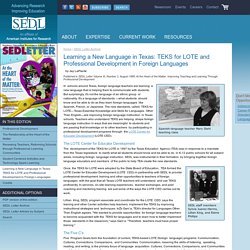
But surprisingly, it's not the language of an ethnic group or nationality. The LOTE Center for Educator Development. Diana Laurillard, Teaching as a Design Science (Routledge, 2012) I’m categorising this post as a review, but in what follows, rather than trying to summarise Laurillard’s wide-ranging achievements, I try to distil the heart of the book – the underlying principles upon which its vision of and suggestions for pedagogy rest.
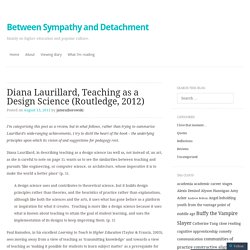
Diana Laurillard, in describing teaching as a design science (as well as, not instead of, an art, as she is careful to note on page 1), wants us to see the similarities between teaching and pursuits ‘like engineering, or computer science, or architecture, whose imperative it is to make the world a better place’ (p. 1). A design science uses and contributes to theoretical science, but it builds design principles rather than theories, and the heuristics of practice rather than explanations, although like both the sciences and the arts, it uses what has gone before as a platform or inspiration for what it creates.
Sometimes an activity will produce what Laurillard terms ‘intrinsic feedback’. Meriden: An Anglican School For Girls. Meriden is a school that equips students to achieve their potential and develop the skills and qualities required for independent, life-long learning. Our students are taught to be flexible thinkers, creative problem-solvers and skilled communicators. From their earliest years at Meriden, students are challenged, supported and inspired to achieve their full potential. They are given opportunities to extend themselves in the classroom, on the sporting field, in the performing arts and in a myriad of other activities. All students are encouraged to participate in Meriden’s vast array of cocurricular activities.
CLIL-CD > European Framework for CLIL Teacher Education. Mathematics. Assessment for Learning Assessment of Learning How can you support your Child? Parents can provide learning support at home in the following ways:Help your child with basics:Number bonds – making 1000, making 100Multiplication tablesSquared numbers – 2x2 , 3x3 ….. 10x10Cubed Numbers – 2x2x2 , 3x3x3, … 10x10x10Relationships – 25% = 0.25 = ¼Memorise formulasProvide opportunities to explore Mathematics through real-life experiences Ask your child to estimateEnsure good time management Sitting through parts of the paper and whole paperPractise Mathematics sums regularlyDo topical revision with your child if he/she is weak so that he/she can experience small measures of success.Always motivate and encourage your child.
Give them confidence. P3 NE Mathematics Trail. The Adoption Curve: How Professors Learn About Change. The study of why and how people adopt new ways of doing things goes back decades. Quality assurance and enhancement - Macquarie University. Formative e-assessment dissemination day. Teaching And Learning Framework - Poetry Sample And Refrence. Keeping It Real: Giving Students Opportunities to Extend and Apply Their Knowledge with Authentic Tasks.
Post submitted by Elizabeth Ross Hubbell, a principal consultant at McREL and coauthor of Classroom Instruction That Works: Research-Based Strategies for Increasing Student Achievement, 2nd edition. Hubbell conducts workshops and training for K–12 teachers on research-based instructional strategies and technology integration, writes curriculum models for online classes, conducts technology audits for districts, and trains school and district leaders in using Power Walkthrough software. In the second edition of Classroom Instruction That Works (CITW), the authors addressed oft-answered questions of when to use the nine categories of research-based instructional strategies and whether the strategies are hierarchical. We included the CITW framework (below) in the new edition because it makes clear the purpose of the strategies.
E-learning - elearning model framework distance education blended learning. Confluence Mobile - Internet2 Wiki. Steve Draper's entrance lobby. Last edited 8 Jan 2015 Comments welcome ( email s.draper@psy.gla.ac.uk). | Contact details | What am I doing now? | Office hours | CV | Profile as project supervisor (e.g. maxis) | My current students | Timer1 Timer2 Fruit machine My clocks page big clock direct | This is the entrance lobby (or home page) for Steve Draper's web pages.
It offers ways to find things in my pages, after helping you check if you have the right person or place. Laurillard model. MMU Strategy for Learning, Teaching and Assessment. Introduction. s2d - iPad - Learning Tool. Post primary sse 15 november 2012. What Else Do We Need to Know and Do? Figure 1.1. Highest Educational Attainment for Every 100 Kindergartners In addition, current trends predict that when these white kindergartners are 17, over 95 percent will be in high school reading at a 12th grade level while 25 percent of their black peers will have dropped out or, if still in school, will read at an 8th grade level (D'Amico, 2001).
Ample evidence shows that these disparities predict not only educational but economic prospects for America's minority populations. In a commentary responding to United States and international achievement comparisons, Bracey (2002), remarks, “We [in the United States] don't have a ‘public school system as we know it.’ Keweenaw Family Discovery Center. Overview. Science. Confluence Mobile - Internet2 Wiki. TL Forum 2009: Earnest, Read and de Mori - LiFE - learning interactively for engagement: A pilot teaching and learning program for refugee students at Curtin University in Western Australia. Academic Computing and Information Services. NUTURE@GESS Framework. Teaching & Learning – Our Model Of Teaching. Recognizing Rigorous and Engaging Teaching and Learning.
Microsoft - Partners in Learning Toolkit. Conceptual Framework. Teaching and learning inquiry. 5 Dimensions of Teaching and Learning. Approach - Partners in School Innovation. Michael Paul Gallo Home, ADHD, Early Childhood Educator, Puppetry, Storytelling. eXplorance - Let's elevate learning. » Social Pedagogies Randy Bass. Software Social E O Seu Contributo Para O Ensino E Aprendizagem - Um Estudo Da Australian Flexible Learning Framework (Parte II) » Framework for Teaching and Learning Johnston CSD. Press Releases - Refreshed Kindergarten Curriculum Framework Spells Out Clearer Learning Outcomes, Emphasises Holistic Development. Framework for 21st Century Learning - P21.
TIEL Institute. Framework - About assessment - Learning and teaching. Reframing the Reform Agenda. St Andrews Lutheran College. Education Review. Book reviews in education. School Reform. Accountability. Assessment. Educational Policy. Google Image Result for. Mark Wenzel, School Superintendent. Teaching and Learning Frameworks - Lessons Learned. Center for Teaching & Learning, American Public University System. Continuing Professional Development: Teaching in Scotland. ELL Teaching and Learning Framework. Course quality framework. Table of Contents. Chapter 4. Adaptable Spaces and Their Impact on Learning – Research – Herman Miller. Teaching and Learning Framework. *E-learner*: WEEK 2. Teaching and Learning Frameworks - Lessons Learned. Green Bay Area Public School District Teaching & Learning Department. Strategies for Engagement. JSPS - JSPS Curriculum. NAPLAN 2012 Teaching Strategies. Characteristics of Improved School Districts. Mobile Pedagogy for English Language Teaching: A Guide for Teachers.
Impact of professional development of teachers on student learning and outcomes in math. Photo : Vanderbilt University The Iris Center Images. 3C Framework. Home - PerL (Personalized Learning) 2014-15 - LibGuides at Robbinsdale Area School. Consitent Teacher Judgement>> Assessment. A Framework for Teaching with Twitter. Aiming at improving teaching and learning « ChiPE project. Towards open participatory learning environments: Reusable and portable OER, educator training & mass collaboration.
Assessment for Learning. FIT Teaching™: The Framework for Intentional and Targeted Teaching™ Programmes, Social and Emotional Learning. A brief guide to Imaginative Education. About - Office of the Associate Vice-President (Teaching & Learning) October 2012 On Point Newsletter. Teaching and Learning with Technology.
Teaching and Learning. Teacher Evaluations - Newark Public Schools. Exploring Learning: Teaching and leading beyond boundaries. History and Overview.